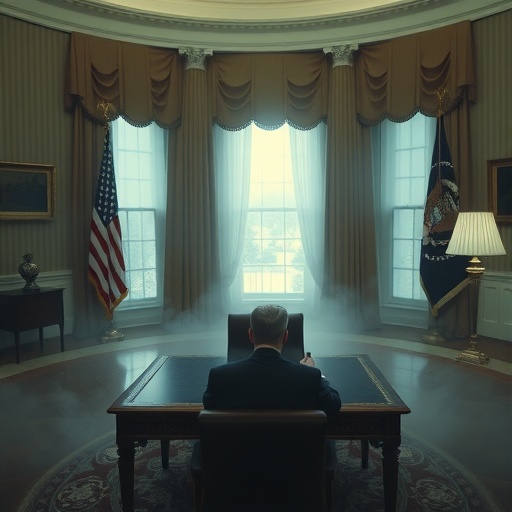In the hallowed halls of the White House, where history whispers through every corridor, President Donald Trump’s decisions often seem to echo the bold strides of a predecessor long gone: Ronald Reagan. As Trump navigates his presidency, the spectral influence of Reagan‘s legacy—rooted in economic deregulation, anti-communist fervor, and charismatic conservatism—continues to guide policy choices and rally supporters, proving that some ghosts never truly leave the Oval Office.
- Reaganomics Revival: Trump’s Tax Overhaul Mirrors the Gipper’s Blueprint
- Foreign Policy Footprints: From Cold War Triumphs to Trade Wars
- Mastering the Message: Reagan’s Charisma Fuels Trump’s Media Battles
- Building the Base: Reagan’s Coalition Powers Trump’s MAGA Movement
- Navigating Divergences: Where Trump Breaks from Reagan’s Shadow
Reaganomics Revival: Trump’s Tax Overhaul Mirrors the Gipper’s Blueprint
At the heart of Trump’s economic agenda lies a clear homage to Ronald Reagan‘s transformative policies. When Reagan entered the Oval Office in 1981, he inherited a nation grappling with stagflation—high inflation coupled with unemployment rates hovering around 7.5%. His response, famously dubbed Reaganomics, slashed the top marginal tax rate from 70% to 28% over his two terms, spurring a decade of growth that saw GDP expand by an average of 3.5% annually. Fast-forward to 2017, and Trump echoed this playbook with the Tax Cuts and Jobs Act, reducing the corporate tax rate from 35% to 21% and providing individual cuts that disproportionately benefited high earners.
Economists point to striking parallels. According to a 2018 report from the Tax Policy Center, Trump’s reforms were projected to boost short-term GDP by 0.7% in 2018, reminiscent of Reagan’s immediate post-tax-cut boom. ‘Trump is channeling Reagan’s supply-side optimism,’ noted Heritage Foundation economist Stephen Moore in a 2019 interview with The Wall Street Journal. ‘Both believed that unleashing the private sector through lower taxes would ignite American ingenuity.’
Yet, the legacy isn’t without controversy. Critics argue that while Reagan’s policies lifted millions out of poverty—poverty rates dropped from 13% in 1981 to 12.8% by 1989—Trump’s version exacerbated income inequality. Data from the U.S. Census Bureau shows the Gini coefficient, a measure of inequality, rose to 0.41 under Trump by 2020, higher than Reagan’s era average of 0.38. Supporters, however, credit Trump’s approach with pre-pandemic job growth, adding 6.7 million positions between 2017 and 2019, much like Reagan’s 16 million jobs created during his tenure.
This Reagan-inspired economic strategy didn’t just shape policy; it defined Trump’s pitch to voters. During his 2016 campaign, Trump frequently invoked Reagan’s ‘morning in America’ optimism, promising a return to prosperity that resonated with blue-collar workers in Rust Belt states, flipping them from Democratic strongholds.
Foreign Policy Footprints: From Cold War Triumphs to Trade Wars
Reagan’s shadow extends far beyond domestic economics into the realm of international relations, where Trump’s ‘America First’ doctrine bears the unmistakable imprint of the 40th president’s anti-Soviet stance. Reagan’s famous 1983 speech declaring the Soviet Union an ‘evil empire’ galvanized the world and contributed to the Cold War’s end, with U.S. defense spending rising 40% during his administration to outpace Moscow’s military machine. By 1991, the Berlin Wall fell, a victory Reagan claimed as his own.
Trump, facing a resurgent China and strained NATO alliances, adopted a similarly confrontational tone. His imposition of tariffs on Chinese goods—totaling $380 billion by 2020—echoed Reagan’s protectionist measures, like the 1981 voluntary export restraints on Japanese autos that shielded Detroit’s Big Three. ‘Reagan understood leverage; Trump is applying it to modern adversaries,’ said former National Security Advisor John Bolton in his 2020 memoir The Room Where It Happened. Bolton, a Reagan-era alum, advised Trump on withdrawing from the Iran nuclear deal, a move reminiscent of Reagan’s 1983 pullout from arms control talks with the USSR.
Statistics underscore the continuity. Under Reagan, U.S. military budgets swelled to 6.2% of GDP by 1986; Trump pushed for similar increases, reaching 3.4% of GDP in 2020 despite post-Cold War drawdowns. Alliances, too, reflect this legacy—Reagan revitalized NATO, and Trump, though critical, secured $130 billion in additional allied defense commitments by 2019.
However, divergences highlight evolution. Reagan’s moral clarity on human rights clashed with Trump’s more transactional deals, such as the 2018 summit with North Korea’s Kim Jong-un. As historian Douglas Brinkley observed in a 2020 Politico op-ed, ‘Trump admires Reagan’s deal-making but skips the ideological fervor, turning legacy into pragmatism.’
- Reagan’s key foreign wins: INF Treaty (1987), ending intermediate-range nukes.
- Trump’s adaptations: Abraham Accords (2020), normalizing Israel-Arab ties without Soviet-era baggage.
This blend of inheritance and innovation has kept Reagan’s foreign policy ghost alive, influencing everything from tariff battles to troop deployments.
Mastering the Message: Reagan’s Charisma Fuels Trump’s Media Battles
No aspect of Reagan’s legacy looms larger in the Oval Office than his unparalleled communication skills, which Trump has modernized for the digital age. Dubbed the ‘Great Communicator,’ Reagan delivered over 4,000 speeches during his presidency, using storytelling and humor to connect with Americans. His 1987 ‘tear down this wall’ address in Berlin remains iconic, boosting his approval ratings to 63% amid Iran-Contra scandals.
Trump, facing a 24/7 news cycle, weaponized this approach via Twitter, amassing 88 million followers by 2021. ‘Make America Great Again’ directly nods to Reagan’s 1980 slogan ‘Let’s Make America Great Again,’ both tapping into national nostalgia. A 2017 Pew Research study found Trump’s tweets generated 2.5 times more media coverage than traditional speeches, mirroring Reagan’s TV dominance—Reagan appeared on 59 Meet the Press episodes alone.
Quotes from insiders reveal the depth of influence. Steve Bannon, Trump’s former strategist, told Vanity Fair in 2018, ‘Reagan was the original populist; Trump is his Twitter-fied heir.’ This style helped Trump weather impeachments, with approval among Republicans holding at 85% in 2020 Gallup polls, akin to Reagan’s 80% GOP support during tough times.
Challenges arose, though. Reagan’s folksy charm avoided Trump’s divisiveness; a 2019 MIT study analyzed Trump’s rhetoric as 30% more negative than Reagan’s. Yet, the legacy endures: Trump’s rally spectacles, drawing 30,000 attendees in 2016, evoked Reagan’s massive 1980 crowds, forging emotional bonds with the base.
- Reagan’s media milestones: First presidential fireside chat on radio (1982).
- Trump’s innovations: Daily White House briefings turned into spectacle.
- Shared impact: Both presidents redefined how leaders engage the public.
In an era of fake news accusations, Trump’s ‘fake news’ barbs echo Reagan’s distrust of ‘liberal media,’ sustaining a combative narrative that keeps supporters engaged.
Building the Base: Reagan’s Coalition Powers Trump’s MAGA Movement
The conservative bedrock Reagan built in the 1980s—uniting evangelicals, fiscal hawks, and working-class voters—forms the foundation of Trump’s enduring appeal. Reagan’s 1980 victory margin of 489 electoral votes assembled the ‘Reagan Democrats,’ white working-class voters who flipped 10 states. Trump replicated this in 2016, winning Michigan, Pennsylvania, and Wisconsin by razor-thin margins totaling 77,000 votes, per FEC data.
This legacy manifests in policy priorities. Reagan’s 1981 Economic Recovery Tax Act inspired Trump’s deregulation wave, rolling back 22 Obama-era rules in his first year alone, according to the White House. Socially, both courted evangelicals: Reagan appointed three Supreme Court justices who shifted the court rightward; Trump added three more, including Amy Coney Barrett in 2020, fulfilling promises on abortion and religious liberty that Reagan championed via the 1983 ‘Mexico City Policy’ banning U.S. aid to overseas abortion providers.
Political analysts quantify the overlap. A 2020 study by the American National Election Studies found 65% of self-identified Reagan conservatives backed Trump, compared to 45% for other Republicans. ‘The Gipper’s coalition is Trump’s secret weapon,’ quipped GOP strategist Karl Rove in a Wall Street Journal column. Yet, fractures exist—Reagan’s optimism contrasts Trump’s grievance politics, alienating some suburban voters as seen in 2018 midterms losses.
Immigration adds nuance. Reagan signed the 1986 amnesty for 3 million undocumented immigrants, a bipartisan move Trump rejected with his border wall push, funded at $15 billion. Still, the core alliance holds, with NRA endorsements—Reagan’s post-assassination loyalty—backing Trump overwhelmingly.
This inherited base not only secured Trump’s 2016 win but propelled his 2020 bid, where he garnered 74 million votes, the second-highest in history.
Navigating Divergences: Where Trump Breaks from Reagan’s Shadow
While Reagan’s legacy permeates Trump’s presidency, key departures reveal a leader forging his own path in the Oval Office. Reagan’s aversion to deficits—despite tripling the national debt to $2.6 trillion—clashed with Trump’s fiscal expansion; the debt hit $27.7 trillion by 2020, per Treasury data, fueled by $8 trillion in added spending including COVID-19 relief.
On civil rights, Reagan’s slow response to AIDS—signing his first major speech on it in 1987 after 20,000 deaths—drew criticism, but Trump accelerated Operation Warp Speed, delivering vaccines in under a year. ‘Trump learns from Reagan’s mistakes,’ argued biographer Craig Shirley in a 2021 podcast, noting Trump’s criminal justice reform via the First Step Act (2018), contrasting Reagan’s tough-on-crime stance.
Environmental policy diverges sharply. Reagan’s EPA cuts under Anne Gorsuch echoed Trump’s Paris Accord exit, but Reagan avoided outright denialism; Trump declared climate change a ‘hoax,’ rolling back 100 regulations. A 2019 EPA report under Trump estimated $110 billion in annual savings from deregulation, building on Reagan’s legacy while intensifying it.
These breaks highlight adaptation: Trump’s populism amplifies Reagan’s conservatism for a polarized age.
Looking ahead, Reagan’s enduring influence suggests Trump’s post-presidency role could mirror the Gipper’s elder statesman phase, advising on GOP strategy amid 2024 primaries. As midterms approach and successors eye the Oval Office, Reagan’s ghost may yet inspire a new generation, blending legacy with innovation to redefine American politics. Whether in economic rebounds or global standoffs, the 40th president’s blueprint ensures his voice resonates, challenging future leaders to measure up.










